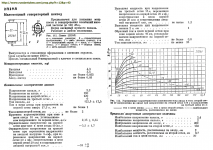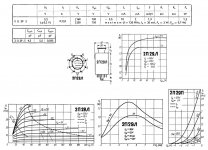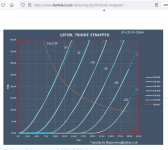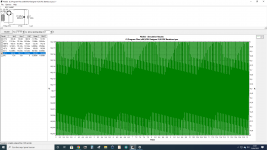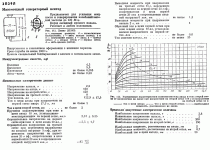Or an input transformer. I use an LL1676 in my 01A preamp with the bias voltage fed through the secondary. It isolates the grid bias voltage from the previous stage and the secondary also acts as a grid choke.its available on ebay, very expansive. look further i understand its more like 71a, you need source of gridbias voltage to operate it properly, so there will be input capacitor
I just tried out 3 line stages into my PSE 4P1L output stage with O'Netics OPTs.
...
2. 2P29L into a single 126C used as plate choke, 0.2uF FT-2 coupling caps
...The 2P29L was closer to the 10Y in sound than to the 26.
...
If you want a considerably cheaper version of a 10Y line stage, use a 2P29L which will give you quite a lot but not all of the 10Y sound. It's also cheaper to use a single 126C as plate choke, and in fact this makes for a very good and very cheap choice if you like plate chokes. ...
Hi Andy,
I have noted this with interest. I have a pair of 126C and also a pair of ISO RC-160-15W that look to be a good match at 15mA, and eight 2P29L and it seems that I should try one of these combinations. What I do not have is data on the 2P29L valve...Ra, mu, and other pertinent data (other than Ale's mu tracer plate characteristics)...can you help with that? I'm interested in building a line stage.
Best, Robert
How does this beat a properly biased and buffered 12AX7 or unbuffered 6922?
I am currently using 6922.
I am currently using 6922.
Hi Robert,Hi Andy,
I have noted this with interest. I have a pair of 126C and also a pair of ISO RC-160-15W that look to be a good match at 15mA, and eight 2P29L and it seems that I should try one of these combinations. What I do not have is data on the 2P29L valve...Ra, mu, and other pertinent data (other than Ale's mu tracer plate characteristics)...can you help with that? I'm interested in building a line stage.
Best, Robert
http://www.vt52.com/node/113

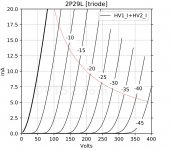
Hi Andy,
What I do not have is data on the 2P29L valve...Ra, mu, and other pertinent data (other than Ale's mu tracer plate characteristics)...can you help with that? I'm interested in building a line stage.
Best, Robert
This is what I have. You should be pretty happy with it. Using a choke allows you to put some current through it, like up to 15mA. I like good chokes!
For stocktrader: How is this better than 12AX7 or 6992? You would have to listen to it with your own ears. A lot of us build with directly heated triodes or trioded pentodes because we hear a nicer sound. If you're following this thread you probably have some curiosity to try a DHT.
Attachments
euro21, Andy, Grazie mille for the 2P29L attachments...mystery solved! No excuses now...I'd better get to work. Best, Robert
2P29L Triode Anode (or Anode + Screen?) Dissipation Limit?
Ale's muTracer anode characteristics plot (Attached) shows a power limit locus to be at 2.7W. The two attachments in euro21's post #5145 show a Pa of 2.0W. Is the difference between the two the dissipation of the screen?
Thanks for any elucidation you might provide...it does make a difference to selecting a design point. Best, Robert
Ale's muTracer anode characteristics plot (Attached) shows a power limit locus to be at 2.7W. The two attachments in euro21's post #5145 show a Pa of 2.0W. Is the difference between the two the dissipation of the screen?
Thanks for any elucidation you might provide...it does make a difference to selecting a design point. Best, Robert
Attachments
Andy what value & power rating do you used?So one of the ways of configuring the input tube is one or two SIC diodes together with a resistor. The resistor feedback takes a bit of the slight edge off the diodes alone.
TIA
Felipe
I use these diodes but there are other SIC diodes available. Voltage drop is 0.8v at these low currents like under 10mA. No need for any heatsink. I can't guarantee that SIC diodes sound good with all tubes - it's very tube dependent, some like it some don't to my ears, no idea why. I think adding a smallish resistor helps because they can sound a little aggressive - harder leading edge to sounds. They do have other virtues, though.
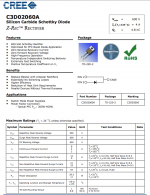

Last edited:
I use the same ones, if I remember well 5 diodes per tube to have near -6V at grid. I want to try the resistor trick to know how it sounds what don't know the resistance value nor the power rating needed or better how to calculate?
It's just a question of experimenting using Ohms law. I haven't listened closely to alternative values of resistor. As a general idea I'd try something between 50 and 100 ohms, then listen to it and see.I use the same ones, if I remember well 5 diodes per tube to have near -6V at grid. I want to try the resistor trick to know how it sounds what don't know the resistance value nor the power rating needed or better how to calculate?
If you are using filament bias you'd get a very different value resistor from standard cathode bias. You probably don't need to use a diode in filament bias, but you could try it.
26 Valve Plate Dissipation Limit ? ? ?
I'm unable to find this parameter. The Tung-Sol data sheet max data for typical operating conditions gives Va max = 180v and Ia = 6.2mA, which equates to a Pd = 1.12W.
Any thoughts or better data?
Thanks, Robert
I'm unable to find this parameter. The Tung-Sol data sheet max data for typical operating conditions gives Va max = 180v and Ia = 6.2mA, which equates to a Pd = 1.12W.
Any thoughts or better data?
Thanks, Robert
I'd stay at more like 7mA and 180v. I've run it there for a while. But why run an old valve like this at more than a comfortable level which would prolong its life?I wouldn't go past 10 mA and 180V.
I'm measuring with my new toy DVM Brymen 869S the B+ AC ripple, but the voltage jumps to 900mV & drops to 700mV always and don't be stabilized with time also measure some weird frequency not 0Hz, the PSU it's a simple bridge rectifier 1000V 25A with a capacitor 820uF 550VDC. Of course no AC ripple when load isn't connected. I expected an AC ripple like the PSUD2 attached simulation. TIA for help & support.
Attachments
Last edited:
- Home
- Amplifiers
- Tubes / Valves
- #26 pre amp
